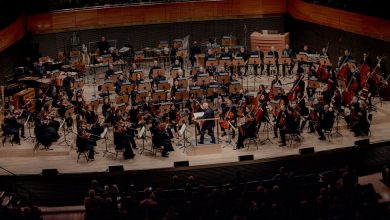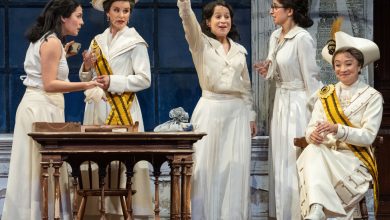Broadway Meets the Avant-Garde in a Juilliard Music Festival

Does “People Will Say We’re in Love,” from Rodgers and Hammerstein’s 1943 musical “Oklahoma,” have anything to, well, say to Lou Harrison’s shimmering Six Sonatas for Cembalo, completed the same year? How does Edgard Varèse’s pensive “Octandre” sound alongside Scott Joplin’s “Maple Leaf Rag”?
These aren’t questions most audiences have ever been asked to consider. But the answers might permit a fuller understanding of the broad range of American music in the first half of the 20th century, a period when this country began to export its own brand of sound.
Unusual but telling juxtapositions abound in “The Making of an American Music, 1899-1948,” this year’s Focus festival at the Juilliard School, which opens for a week of performances on Sunday. Each year Focus zeros in on a specific topic in modern music; the 2022 iteration brings together — and demonstrates the substantial overlap between — worlds not often united in the history books or on concert programs: ragtime, jazz, Broadway, Americana, global music, dance and the Europe-descended avant-garde.
Joel Sachs, the festival’s organizer and the longtime doyen of new music at Juilliard, said that “The Making of an American Music” emerged out of brainstorming for the 2021 festival. With a presidential inauguration then looming, he thought of 1921, the start of Warren G. Harding’s term, and its implications for international affairs.
“Music in times of trouble” was to have been the theme, Sachs said by phone recently, with a week focusing on the two decades from the end of the First World War to the eve of the Second, including politically charged pieces by the likes of Charles Ives, Stefan Wolpe and Hanns Eisler. But Sachs hadn’t gotten past rough plans before the festival was canceled because of the pandemic.
“Then came 2021,” he said, “and things beginning to look better, and a sense we might be getting out of this situation, which turned out to be not quite right. But I started to think that was too gloomy a subject.”
He turned his attention specifically to the American repertory, and, using the enormous New Grove Dictionary of Music and Musicians, put down all the composers writing in the first 50 years of the 20th century; there were almost 300 names. He and David Ludwig, the new dean and director of Juilliard’s music division, then independently drew on that for lists of 15 “musts” and 15 “maybes.” (Their top tiers, as it happened, were almost identical.)
“It blossomed into a kind of monster,” Sachs said, chuckling. “The program book is 88 pages. But it’s a really interesting period.”
These are the six Focus programs, starting on Sunday evening:
Sunday
A set of Joplin’s rags — the phenomenally popular sheet music for “Maple Leaf Rag” helped put American music on the global map — leads directly into two of Ives’s bustling, changeable Ragtime Dances, performed by Sachs’ New Juilliard Ensemble. The rapidly shifting moods of the dances will offer a new context for the similarly jittery “Octandre,” written for a small group of winds and brasses and ending in a bright scream. Varèse, a native Frenchman, spent the last 50 years of his life in America, and his influence here made him a natural for this Focus.
Sachs wrote a biography of Henry Cowell, who was part of a circle of experimental composers with Varèse, and whose brooding Sinfonietta follows “Octandre.” Ruth Crawford was also part of the group, and the program includes her angular “Three Songs to Poems by Carl Sandburg,” before closing with Ives’s Third Symphony, “The Camp Meeting,” a characteristically Ivesian explosion of European styles and 19th-century Americana.
Monday
The military marches of John Philip Sousa, a major American presence in Europe during this period, are rarely heard alongside modernists like Milton Babbitt and Leon Kirchner, and Amy Beach’s String Quartet is rarely heard, period. Beach’s warm, thickly chromatic, intensely elegant single-movement quartet — which incorporates, after the model of Dvorak, the Native American melodies “Summer Song,” “Playing at Ball” and “Ititaujang’s Song” — looks both backward and forward.
The quartet and chamber works by Babbitt, Kirchner, Conlon Nancarrow (best known for his wild player-piano studies) and Virgil Thomson lead, however unexpectedly, to Sousa’s “The Stars and Stripes Forever,” represented by Vladimir Horowitz’s virtuosic — and, in this company, truly progressive-sounding — piano arrangement.
Tuesday
Among the week’s most intriguing rediscoveries is “Deep Song,” a Martha Graham solo that she first danced in 1937 as a cri de coeur during the Spanish Civil War. The score, by Cowell, was lost, so when the dance was revived in the 1980s, it was with another Cowell piece.
The correct music — created using an innovative technique that let the choreographer rearrange modular phrases as needed — was rediscovered in the early 2000s. So this collaboration with Terese Capucilli, a Graham expert who teaches at Juilliard, will be the modern premiere of a substantial re-creation of the original, set alongside chamber works by John Cage, Walter Piston, Roger Sessions and Aaron Copland.
Wednesday
A very brief history of the transition from ragtime to jazz — including pieces by Eubie Blake, Mary Lou Williams, James P. Johnson and Duke Ellington — is the climax of a program that also includes an aria from Gian Carlo Menotti’s popular opera “The Medium,” William Grant Still’s eloquent “Incantation and Dance” for oboe and piano, and works by Vincent Persichetti, Wolpe and Elliott Carter.
Thursday
Refractions of other cultures by Colin McPhee (drawing on Balinese melodies) and Alan Hovhaness (on the kanun, an Armenian zither) join a two-piano arrangement of Carl Ruggles’s “Organum” and the slow movement of Samuel Barber’s Op. 11 String Quartet, which he later arranged as the famous Adagio for Strings.
The “Festival Prelude” for organ by Horatio Parker, Ives’s teacher at Yale, is delightfully paired with Ives’s own nutty organ variations on “America”; Harrison’s cembalo sonatas; and a sampling of Broadway songs by Berlin, Kern, Porter and Rodgers — capped by a two-piano version of Gershwin’s variations on “I Got Rhythm.”
Friday
The culminating event features, as usual, the Juilliard Orchestra, the school’s main symphonic ensemble; Mei-Ann Chen, the music director of the Chicago Sinfonietta, conducts. Joplin is once again on the program, in the form of the lively overture to his 1910 opera “Treemonisha,” which was first staged in 1972 and for which he was posthumously awarded a Pulitzer Prize.
Another long-overlooked composer, Florence Price, is represented by her lyrical Violin Concerto No. 1, with Timothy Chooi as soloist. And Ives, that great masher of genres, closes this genre-mashing festival with his grandly impassioned Second Symphony, which weaves American songs and hymns throughout.




